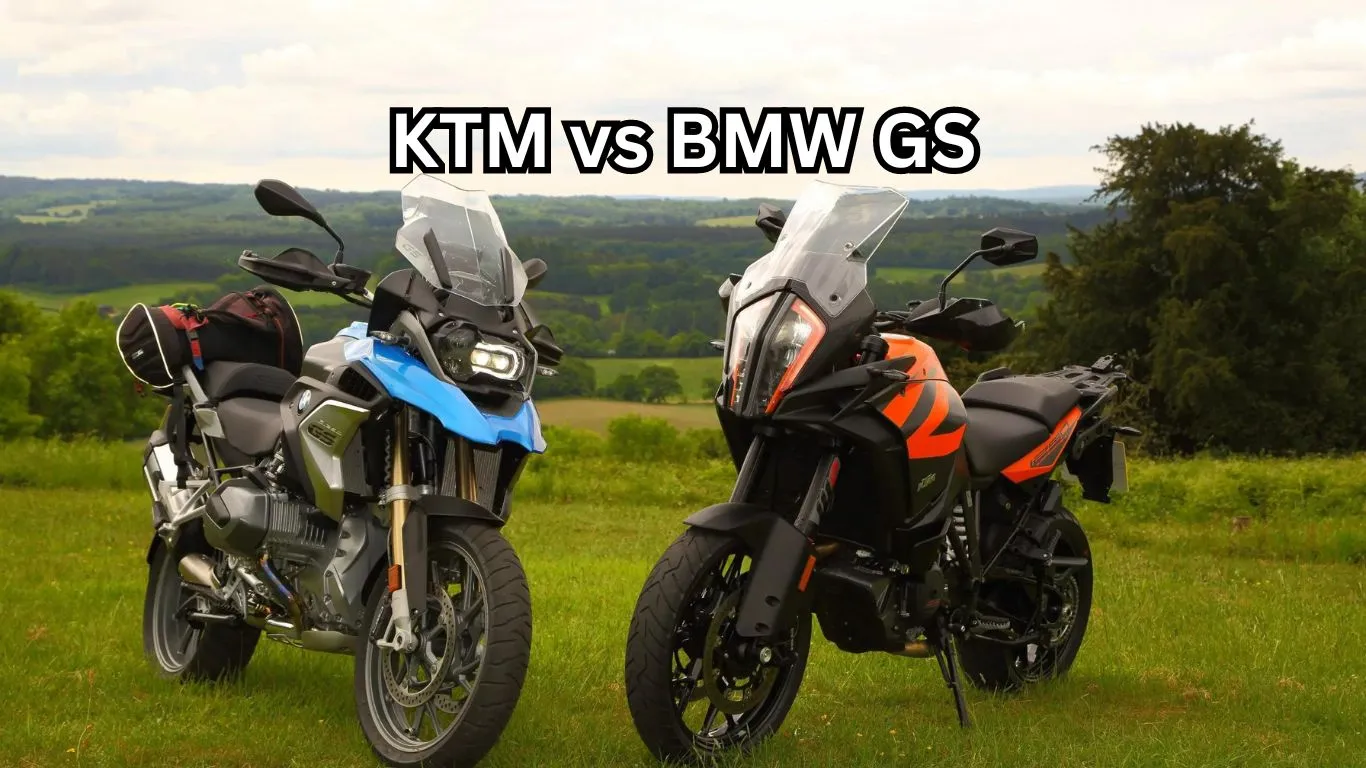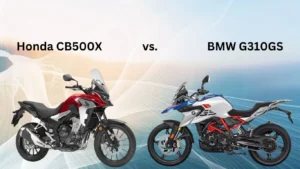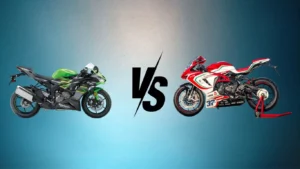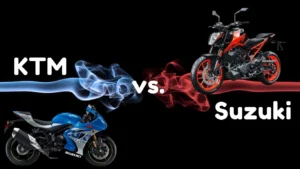When it comes to deciding on the right bike for your next adventure, two renowned manufacturers typically come to mind: KTM and BMW. If you’re caught in the head-to-head comparison of the KTM Duke against the BMW GS, you’re not alone. Many seasoned riders and new enthusiasts alike find themselves pondering this decision. In this article, we’re going to delve into the heart of this debate, providing you with all the facts you need to make an informed choice.
“The KTM Duke offers unparalleled agility whereas the BMW GS has inherited the benefits of a time-tested lineage in the adventure segment.”
- The KTM Duke: Known for its phenomenal performance and beast of an engine – the Duke is not your typical ride.
- The BMW GS: With a history steeped in providing top-notch adventure motorbikes, the GS line combines comfort, durability, and long-haul appeal.
In this side-by-side comparison, we’ll dissect the key aspects of each model, from power and performance to comfort and price. It’s time to kick-start your journey into the KTM vs BMW GS showdown.
Understanding the Heritage: KTM vs BMW GS
Take a ride back in history with us as we explore two trailblazing motorcycles – the KTM and the BMW GS. These are more than just bikes; they carry legacies etched deep into the rugged lines of off-road motorcycling.
The Adventurous KTM
Birthed from the racing thrills of Austria, KTM rose to prominence in the 1950s. Initially producing lighter-weight motorcycles, the intuitive line known as the ‘Enduros’ essentially put KTM on the world motorcycling map. In recent years, the brand has continued to evolve, pushing the limits with unabated innovation and design.
- In 1990, KTM launched the Duke series, substantially impacting the global motorcycle market.
- 1992 saw the emergence of the Adventure series, offering enhanced off-road and touring capabilities.
- KTM’s recent partnership with Bajaj Auto has facilitated its entry into varied markets, increasing its global reach and visibility.
BMW GS: Conquering Terrains Since 1980
BMW GS has been a legend ever since its inception in 1980. Originating from Germany, the GS, which stands for “Gelände/Straße” (off-road/road), establishes its niche in the dual-sport bike arena. It doubles up as a tourer, capable of conquering different terrains while providing comfort over long distances.
| 1980 | Introduction of the R80 G/S, the first of the GS series. |
|---|---|
| 1988 | The R100GS, with its signature boxer engine and improved suspension, became a flagship model of the GS series. |
| 2004 | Launch of the R1200GS, the first GS model to feature a two-cylinder boxer engine, marking a significant improvement in both power and torque. |
While both bikes bear their distinct heritage and have evolved over the years, their ultimate aim remains the same – to provide an unrivaled off-road motorcycling experience.
Breaking Down the Beast: Key Features of KTM and BMW GS
If you’re a seasoned rider, surely you know that the true grit of a motorcycle lies in its key features and functionalities. KTM and BMW GS, two heavyweights in the off-road biking world, are packed with unique features geared towards mastering different terrains. Let’s dive right in and examine what sets these machines apart.
Core Features of KTM
Known for its sport-oriented design, KTM motorcycles aren’t just your average bikes. You’d be enthralled by their stupendous speed and maneuverability, thanks to:
- Lightweight Chassis: KTM is famous for its minimalist bodywork, putting your handling agility at the forefront
- Powerful Engine: Fueled by a Twin-Cylinder engine, KTM’s endurance on the highway, as well as in off-road conditions, is remarkable
- Advanced Suspension: Coupled with WP adjustable forks, KTM ensures a silk-smooth ride on bumpy terrains
Performance Statistics for KTM
Before we move on to BMW GS, let’s take a peek at some data to solidify our understanding.
| SPECIFICATION | VALUE |
|---|---|
| Engine displacement | 373cc |
| Maximum speed | 174 km/h |
| Fuel Tank Capacity | 13.4 litres |
The Winning Features of BMW GS
BMW GS, on the other hand, stands as a testament to the brand’s fusion of power and comfort. Be it a country trail or a rocky path, BMW GS will gratify you with:
- Robust Engine: Propelled by a dynamic boxer engine, BMW GS delivers consistent power
- Remarkable Comfort: With heated grips and a high-back-up seat, BMW GS goes a long way in optimizing rider comfort
- Customizable Riding Modes: From rain to road to dynamic, choose the mode that aligns with your journey
Performance Statistics for BMW GS
Let’s take a look at some key statistics for BMW GS to get the complete picture.
| SPECIFICATION | VALUE |
|---|---|
| Engine displacement | 1254cc |
| Maximum speed | 200 km/h |
| Fuel Tank Capacity | 20 litres |
To wrap up, whether you vouch for the sportiness of KTM, or the versatility of BMW GS, you’re in for a fantastic blend of speed and comfort that will make every ride a worthwhile adventure.
Dollar for Speed: Pricing Showdown between KTM and BMW GS
Understanding the value proposition is crucial when you’re deciding between the KTM and the BMW GS motorcycles. After all, a smart consumer is one who considers the multiple aspects of the investment, which in this case is not just the purchase price but also the long-term cost of ownership.
The Actual Price Tag: KTM vs BMW GS
Let’s start by looking at the raw numbers, shall we? A new KTM can range anywhere from $4,199 for the smallest 125cc model to a whopping $19,599 for the fully-equipped 1290 Super Adventure R. Of course, the model you choose will depend on your personal requirements and preferences.
The BMW GS series, on the other hand, starts at a higher price point – around $15,995 for the entry-level F 750 GS and can soar up to $23,095 for the fully-loaded R 1250 GS Adventure. Therefore, BMW GS models are typically costlier than KTM bikes. As with any purchase decision, you must weigh the brand reputation, performance, design, and features against your budget.
More than just a Price Label
If you focus solely on the initial price tag, you might miss out on the bigger picture. Let’s dig a little deeper, shall we?
- Resale value: BMW bikes are known for their strong resale value, owing much to their prestige and quality build. However, KTMs also hold their value well and could offer you a good chunk of change when it’s time to upgrade.
- Insurance: Depending on your location and age, insurance rates can vary. Nevertheless, be prepared for higher premiums with the sports-oriented KTMs versus the more adventure-focused BMWs
- Fuel Efficiency: Both brands offer fuel-efficient models but BMW GS possesses slightly better mileage figures.
Long Term Costs: Maintenance and Servicing
It’s important to consider longer-term costs such as maintenance and servicing. Typically, KTMs could cost less to service but their parts can be pricier than those of BMWs. On the other hand, BMW is renowned for its top-notch service, so even if you’re shelling out more for maintenance, you’re assured of quality.
Ultimately, the ‘dollar for speed’ debate is subjective and boils down to your personal preference, usage, and budget. Neither brand is strictly ‘cheaper’, but each offers its own value proposition.
Technology and Innovation: Advanced Features
In the world of motorbiking, you are not just looking for a machine that can quench your thirst for exhilarating winds and landscapes. You look for an experience. Now, let’s delve into the tech marvels these bikes introduce to enhance your riding experience.
High-Tech Additions in KTM
Starting off with KTM, which is renowned for its solid build quality and excellent performance. KTM’s technology portfolio is just as impressive. Most notable features include:
- Ride Modes: The KTM comes with different ride modes, ensuring maximum adaptability in any environment.
- MTC (Motorcycle Traction Control): This ingenious feature ensures maximum grip and controlled power delivery.
- Quickshifter+: A highly convenient feature allowing you to upshift and downshift without the need for a clutch.
Advanced Safety Features
While thrill is paramount in biking, KTM doesn’t compromise on safety. From exceptional breaking systems, lean-sensitive electronic aids to effective slip regulation, the KTM offers everything to ensure a safe ride.
- Motor Slip Regulation (MSR): It prevents the rear wheel from locking up due to aggressive downshifting.
- Lean-sensitive ABS: It allows you to brake effectively regardless of the bike’s position or the terrain.
BMW GS: Meeting the Future Head-On
Moving on to BMW GS, BMW Motorrad has always been a forward-thinking brand, with a sharp focus on advanced technologies. Find out what sets the GS apart:
- Dynamic ESA: This electronic suspension adjustment system allows riders to adapt their GS more accurately to their needs and route conditions.
- Ride Modes Pro: With multiple riding modes, riders can tailor their BMW GS to perfectly match their riding style.
Connectivity and User Interface
When it comes to digital resources, BMW GS takes a commanding lead, offering more than just ride adjustments.
- App Connectivity: The BMW GS connects easily with mobile apps, offering riders a host of features and information at their fingertips.
- TFT Display: With the GS series, BMW introduced the TFT display that offers clear visibility of important information and easy_scroll-through menus.
Servicing and Maintenance: Cost of Ownership
We know that when considering a motorbike for purchase, one of the primary factors to contemplate is the cost of ownership and maintenance. Let’s dig into the ease and expense involved in servicing and maintaining the KTM and BMW GS motorbikes.
Whats on demand with KTM’s Maintenance
Maintenance for a KTM bike can be quite an ask, especially if you’re a serious rider. It’s not just about keeping the bike riding smoothly but also ensuring its high-performance components are in top-notch form. Some primary maintenance needed for the KTM includes:
- Regular oil and oil filter changes that can be frequent for high-performance riding
- Chain cleaning and lubrication after every ride in dirty or dusty conditions
- Brake pads and tyres, which will wear out faster depending on usage
- Engine coolant, spark plugs and air filters need routine checks and replacement
BMW GS Maintenance: Built to Last
The BMW GS, on the other hand, is somewhat famed for its enduring quality and reliability. Here’s a snapshot of regular maintenance tasks you can expect:
- Less frequent oil changes, thanks to BMW’s advanced engine technology
- Chain drive needs regular cleaning and lubrication, similar to the KTM
- Brake-fluid change only every two years
- Valve clearance inspections and adjustments are less regular than on the KTM
A Tale of Two Budgets
While the KTM does demand a little more care, the rewards of such attentiveness can be worth it if you’re a true performance enthusiast. On the other hand, the BMW GS is arguably easier on the budget for long-term maintenance – an element that plays into its case as a touring and adventure machine.
Let’s take a table view for a better comparison:
| Maintenance Task | KTM | BMW GS |
|---|---|---|
| Oil Change | Frequent | Less Frequent |
| Chain Cleaning and Lubrication | After Every Dirty or Dusty Ride | Regular |
| Brake Pads and Tyres | Faster Wear-out | Relatively Slower Wear Out |
| Valve Clearance Inspections and Adjustments | More Frequent | Less Frequent |
In the end, the decision between KTM and BMW GS isn’t just about an immediate purchase price. It’s about considering the total cost of ownership over the years, factoring in servicing, maintenance, and the overall quality of the riding experience. Your personal priorities as a biker will ultimately decide the best fit for you.
The Final Verdict: KTM vs BMW GS
If you’ve followed us this far, you’re probably itching to know- who wins the battle between KTM and BMW GS? As much as we’d love to give you a clear cut answer, we understand that your choice of bike depends on various factors including your riding style, budget and personal preferences. That said, let’s round up the comparison of these two stellar bikes with what we’ve learned so far.
Weighing the Options: KTM vs BMW GS
On one hand, the KTM’s core strength lies in its high-performance specs. This lightweight machine packs a robust power while giving you ample room for customization:
- Potent and agile performance on both on-road and off-road terrains
- Impressive technology and safety features
- Economical in terms of initial cost and maintenance
On the other hand, BMW GS offers a balanced blend of luxury, performance, and reliability:
- Unmatched comfort and utility features for long-distance touring
- Road-oriented performance with versatile off-road capabilities
- Advanced connectivity options and user-friendly interfaces
Tips for your Decision
Both KTM and BMW GS are splendid choices for motorbike lovers, yet they appeal to two different spectrums of riders. Follow these tips to help guide your decision:
- If you want a high-performance adventure bike that balances on-road and off-road abilities, and you don’t mind getting your hands a bit dirty on maintenance- KTM might be your ride.
- If your journeys include long-distance traveling and you value comfort, utility, and sophisticated technology along with reliability- BMW GS could be the way to go
Here’s Your Summary Table:
| KTM | BMW GS | |
|---|---|---|
| Performance | High-performance, versatile on-off road | Comfortable touring, decent off-road |
| Technology & Safety | Advanced tech with room for customization | Superior, integrated and user-friendly |
| Cost | More economical, higher maintenance | Higher initial cost, lower maintenance |
In conclusion, the choice between KTM and BMW GS is essentially about balancing your passion with practicality. Feel free to choose the bike that not only fits your present needs but also allows room for your riding ambitions to flourish in the future.






